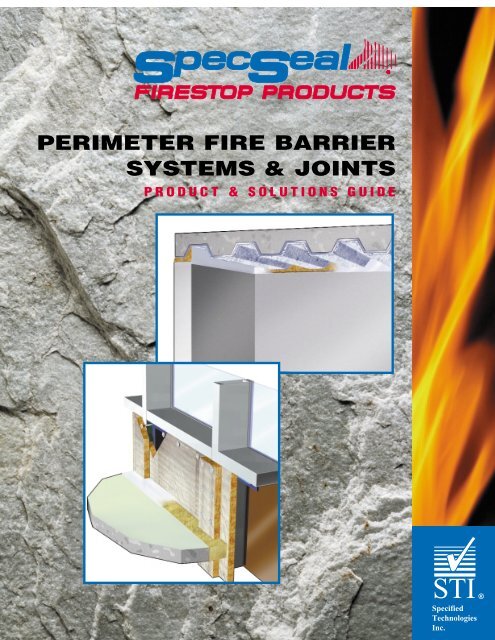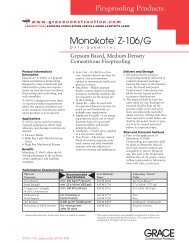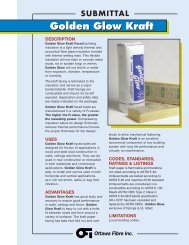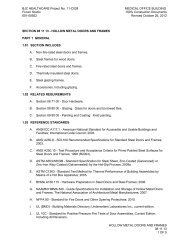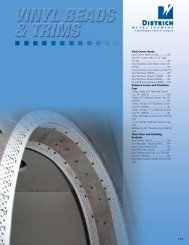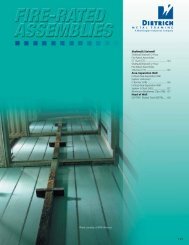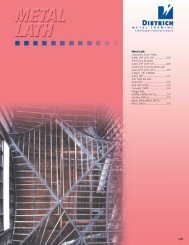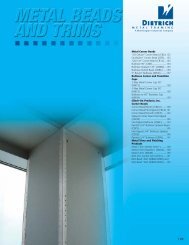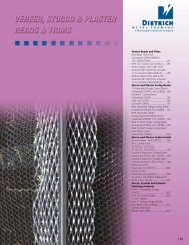perimeter fire barrier systems & joints product ... - Ncs-stl.com
perimeter fire barrier systems & joints product ... - Ncs-stl.com
perimeter fire barrier systems & joints product ... - Ncs-stl.com
You also want an ePaper? Increase the reach of your titles
YUMPU automatically turns print PDFs into web optimized ePapers that Google loves.
PERIMETER FIRE BARRIER<br />
SYSTEMS & JOINTS<br />
PRODUCT & SOLUTIONS GUIDE<br />
STI®<br />
Specified<br />
Technologies<br />
Inc.
Products & Solutions<br />
for Firestopping Joints &<br />
Construction Gaps<br />
When it <strong>com</strong>es to <strong>fire</strong> resistance testing and methodology, construction <strong>joints</strong><br />
and gaps have received a lot of much needed attention in recent years. New<br />
test standards, changes in testing methods, test apparatus, and the codes<br />
themselves can be a bit confusing for the specifier, installer, or building<br />
inspector. STI prides itself on being a leader in this field and as a leader we<br />
believe in providing more than just <strong>product</strong>s. This is a solutions guide designed<br />
to provide you with both the answers you need as well as some of the<br />
questions that you may need to ask to make sure these critical areas are<br />
sealed safely and effectively.<br />
What Are Joints and Construction Gaps?<br />
While virtually any linear opening in a building is generally referred to as a<br />
joint, the industry as well as the codes have begun to differentiate according to<br />
the nature of the opening and why it has been created as well as what it is<br />
expected to do. The word joint implies movement and some gaps may be<br />
created to allow for movement due to expansion and contraction, <strong>com</strong>pression<br />
and deflection of opposed structural members. Other factors such as seismic,<br />
wind sway, and exposure to temperature changes and sunlight are also factors.<br />
However, other openings may also be created that see little or no movement<br />
and simply mark the line of demarcation between one building surface and<br />
another. Whether the application has movement (dynamic) or has no<br />
appreciable movement (static), STI has the <strong>systems</strong> and designs to help<br />
architects, specifiers, and installers do the job right.<br />
How Are These Openings Tested?<br />
As we mentioned above, there have been a lot of changes in regards to testing<br />
methods and standards. To the right we have provided a summary of<br />
standards that relate to linear openings along with a short explanation of just<br />
what they are intended to do. Space precludes our providing greater detail and<br />
all of these standards have been subject to a great deal of activity that may<br />
result in future revisions. We encourage you to consult the local authority<br />
having jurisdiction for particular requirements. STI leads the industry in<br />
innovative safety testing. We have indicated where appropriate, the testing<br />
methods used in each application category.<br />
Doing The Job Right!<br />
Please remember that these test standards are generally limited in scope to<br />
issues relating to <strong>fire</strong> resistance and movement capabilities. Achieving results<br />
that match tested performance also requires proper installation techniques.<br />
We have provided a few tips and pointers relating to the application of sealants.<br />
We encourage you to consult ASTM C1193 Standard Guide For the Use of<br />
Joint Sealants for additional helpful information that will greatly assist you<br />
whether your function is to specify, install, or inspect these critical areas.<br />
®<br />
Innovating Means Being First!<br />
First to Test & Classify...<br />
• Curtain walls with vision glass.<br />
• Head-of-Wall <strong>joints</strong> with <strong>fire</strong> proofed<br />
roof deck.<br />
• Head-of-Wall <strong>joints</strong> with <strong>fire</strong><br />
proofed flutes.<br />
• Head-of-Wall with <strong>fire</strong> proofed<br />
structural penetrants.<br />
• Caulk & Walk Head-of-Wall solutions.<br />
A Summary of Testing Methods Used to<br />
Evaluate Rated Construction Joints and<br />
Gaps<br />
• ANSI/UL2079 (Tests for Fire Resistance of<br />
Building Joint Systems) details movement<br />
cycling and <strong>fire</strong> test methods for linear<br />
openings. Recently revised to require 500<br />
cycles (cpm) at 1 cpm for thermal, 10 cpm<br />
for wind sway, and 100 cycles at 30 cpm<br />
for seismic.<br />
• ASTM E1966 (Test Method for Fire<br />
Resistive Joint Systems) adopted in 1998<br />
is similar to UL2079's <strong>fire</strong> testing methods.<br />
• ASTM E1399 (Test Method for Cyclic<br />
Movement and Measuring the Minimum<br />
and Maximum Joint Widths of Architectural<br />
Joint Systems) revised in 1997 is similar to<br />
UL2079's revised cyclic movement testing.<br />
• AC30 (Acceptance Criteria for Joint<br />
Systems) ICBO ES acceptance criteria for<br />
joint designs meeting the requirements of<br />
Section 706 of the Uniform Building Code.<br />
Matches the cycling requirements of<br />
UL2079's latest revision.
STI SpecSeal Products for Joints & Construction Gaps...<br />
Choose<br />
The Right<br />
Products<br />
APPLICATION PERFORMANCE COSTS<br />
Movement Installation<br />
Application Material Clean Application Tack Free Cure Chem. In Service UL 2079 Ext./Comp. Material Production Installed<br />
Method Base Up Temp Time Time Resist. Temp. Range Tested (+/-) Cost Rates Cost<br />
Series ES Gun Grade Acrylic Water 40-95°F 2 Hours 5-7 Days Good ≤120°F (49°C) Yes ± 15% Best Better Better<br />
Series AS Spray Grade Acrylic Water 60-90°F 2 Hours 1-2 Days Good ≤120°F (49°C) Yes ± 18.75% Better Best Best<br />
Series PEN/ Gun Grade/<br />
PEN (SL) Self-Leveling Silicone Min. Spirts (35)-140°F 5-9 Hours 10-14 Days Best ≤ 350°F Yes ± 50% Good Good Good<br />
Grade<br />
Series ES<br />
Series AS<br />
Latex-based gun grade<br />
elastomeric coating<br />
Series PEN<br />
Latex-based, spray<br />
applied elastomeric<br />
coating<br />
Single <strong>com</strong>ponent,<br />
neutral cure, premium,<br />
highly elastomeric<br />
silicone rubber<br />
DESCRIPTION: Elastomeric Sealant<br />
Color: Pale Blue Odor: Mild Latex<br />
FEATURES & BENEFITS:<br />
Elastomeric = Joint movement up to ±15%<br />
Water based = Easy installation and clean up<br />
Water resistant when cured = No reemulsification<br />
Nonhalogenated = Safe<br />
Thixotropic = High-build application<br />
Autobonding = Good retrofit adhesion<br />
No solvents, No asbestos = Safe<br />
Tested to UL2079 = Meets new test standard<br />
Acoustical Sealant = Reduced sound transmission<br />
PACKAGING:<br />
ES100 10.3 Oz. Caulk Tube (304 ml) 18 cu. in.<br />
ES129 29 Oz. Caulk Tube (858 ml) 52 cu. in.<br />
ES120 20 Oz. Sausage (592 ml) 36 cu. in.<br />
ES105 5 Gallon Pail (19 liters) 1,155 cu. in.<br />
MORE INFORMATION: Call STI "Facts On Demand"<br />
(888-526-6800) and request document number 5032 to<br />
receive your copy of the Series ES Product Data Sheet.<br />
DESCRIPTION: Elastomeric Spray<br />
Color: Pale Blue Odor: Mild Latex<br />
FEATURES & BENEFITS:<br />
Tested with direct - applied <strong>fire</strong>proofing<br />
Elastomeric = Joint movement up to ± 18.75%<br />
Water based = Easy installation and clean up<br />
Water resistant when cured = No reemulsification<br />
Spray applied = Fast application<br />
Nonhalogenated = Safe<br />
Thixotropic = High-build application<br />
No solvents, No asbestos = Safe<br />
Low abrasion = Longer pump life, Less tip wear<br />
Tested to UL2079 = Meets new test standard<br />
PACKAGING:<br />
AS205 5 Gallon Pail (19 liters) 1,155 cu. in.<br />
MORE INFORMATION: Call STI "Facts On Demand" (888-<br />
526-6800) and request document number 5042 to<br />
receive your copy of the Series AS Product Data Sheet.<br />
DESCRIPTION: Silicone Sealant<br />
Color: Concrete Odor: None<br />
FEATURES & BENEFITS:<br />
Premium silicone = Excellent long-term aging<br />
Neutral cure = Odorless application<br />
Excellent adhesion = Positive, long lasting bond<br />
Highly elastomeric = Allows ±50% movement<br />
Autobonding = Allows repairs & modifications<br />
Tested to UL2079 = Meets new test standard<br />
PACKAGING :<br />
PEN300 10.3 Oz. Caulk Tube (304 ml) (Gun Grade)<br />
PEN305 5 Gallon Pail (19 liters) (Gun Grade)<br />
PEN305SL 5 Gallon Pail (19 liters) (Self-Leveling)<br />
MORE INFORMATION: Call STI "Facts On Demand"<br />
(888-526-6800) and request document number 5005 to<br />
receive your copy of the Series PEN Product Data Sheet.<br />
After spraying Series AS,<br />
Series ES sealant may be<br />
used to touch up or repair<br />
the spray application<br />
JOINTS
Perimeter Fire Barrier Systems<br />
®<br />
New Test Standards & Test Apparatus Help Put the SAFE in Safing!<br />
Joint testing until recently has involved <strong>fire</strong>stops installed between two<br />
equally rated building surfaces. Since curtain walls either have no rating at<br />
all or at best a rating that is lower than the adjacent floor, sealing the safing<br />
area has been at best a matter of assumptions and a lot of guesswork.<br />
Innovative testing has established STI as the leader in <strong>fire</strong>stopping and<br />
smoke sealing <strong>perimeter</strong> <strong>fire</strong> containment <strong>systems</strong>. Read on and we'll<br />
show you why SpecSeal Series AS Elastomeric Spray is rapidly be<strong>com</strong>ing<br />
the <strong>product</strong> of choice for design professionals who care about the safety of<br />
their buildings.<br />
STI's Re<strong>com</strong>mended Products...<br />
SpecSeal Series AS Elastomeric Spray<br />
is your best choice for effective and<br />
economical sealing of safing areas.<br />
AS adheres tenaciously to concrete,<br />
foil, mineral wool, and most metals. It<br />
applies rapidly and easily using airless<br />
spraying equipment. Where required,<br />
AS applies evenly on top of mineral<br />
wool and won't soak in. Water-Based<br />
(rather than water borne) means easy<br />
application and cleanup with no<br />
solvents required.<br />
State-of-the-Art Systems...<br />
Notice that we have mentioned the terms Perimeter Fire Barrier Systems<br />
and Perimeter Fire Containment Systems rather than simply referring to<br />
<strong>joints</strong>. That's because all of the elements of the floor and wall construction<br />
as well as the safing slot are inter related in terms of the performance of<br />
the assembly as a whole. The safing area will not perform any better than<br />
the weakest of the adjacent construction elements. Thus the safing slot<br />
must be tested as part of an assembly that is representative of the actual<br />
field condition.<br />
Compare <strong>systems</strong> and testing... STI conducted the industry's first test that<br />
included exposed vision glass rather than a totally insulated curtain wall.<br />
Call us and find out how we can help solve your design or applications<br />
problems with solutions that are fully tested and approved.<br />
Test Methods & Standards<br />
For Perimeter Fire Barrier Systems:<br />
Fire Resistance Testing:<br />
UL and other major labs use testing based upon the<br />
proposed standard for Testing Perimeter Fire Barrier<br />
Systems (See I.S.M.A. test to the right).<br />
Cyclic Movement: Assumed to be negligible in<br />
most designs. Where indicated, tested to UL2079<br />
and ASTM E1399.<br />
PUTTING Perimeter Fire Barrier<br />
Systems To The Test...<br />
The I.S.M.A.<br />
Based upon a flammability test for curtain walls<br />
containing <strong>com</strong>bustible <strong>com</strong>ponents (UBC 26-9)<br />
The Intermediate Scale Multi-Story Apparatus<br />
or I.S.M.A. for short, was developed as a flame<br />
spread test for flammable curtain wall constructions<br />
(UBC 26-9) and has been adopted for use<br />
in testing Perimeter Fire Barrier Systems.<br />
Unlike a traditional ASTM E119 furnace test that<br />
would expose only the underside of a concreteto-concrete<br />
joint, the ISMA exposes not only the<br />
floor/joint area to <strong>fire</strong> but is also designed to<br />
simulate a <strong>fire</strong> that burns out the windows and<br />
climbs the exterior wall of the building. The<br />
joint is evaluated as a part of the <strong>perimeter</strong><br />
system including the curtain wall assembly.
All Tested Systems Include Windows... Don't They??<br />
How Much Movement Occurs in a Safing Slot?<br />
If you pay close attention in this brochure, you'll see very few references to <strong>joints</strong> when it<br />
<strong>com</strong>es to curtain walls. As we mentioned, the word <strong>joints</strong> implies movement and when it<br />
<strong>com</strong>es to curtain walls, most experts agree that very little movement actually occurs in the<br />
safing area.<br />
Over-estimating movement can lead to joint designs that overload mineral wool and stress<br />
critical structural wall elements during a <strong>fire</strong>. STI's tested designs are based upon the<br />
re<strong>com</strong>mendations of experts and achieve the necessary balance between ease of installation,<br />
protection of structural elements, and the expected movement within the safing area.<br />
You might assume that since<br />
windows are a standard<br />
<strong>com</strong>ponent of all curtain wall<br />
designs, all tested <strong>systems</strong><br />
would naturally include them...<br />
You would be wrong! STI has<br />
published the first system that<br />
incorporates non-insulated glass<br />
vision panels.<br />
Windows are well known to be<br />
the achilles heal of the curtain<br />
wall when it <strong>com</strong>es to <strong>fire</strong><br />
resistance. Most published<br />
<strong>systems</strong> tested by third-party<br />
labs incorporate totally insulated<br />
spandrel panels and do not<br />
include vision glass.<br />
The inclusion of windows and<br />
their position and spacing are a<br />
major factor in the overall<br />
performance of a <strong>perimeter</strong> <strong>fire</strong><br />
<strong>barrier</strong> system. Insulation and<br />
safing <strong>systems</strong> designed for<br />
assemblies that include windows<br />
may be dramatically different<br />
than test assemblies that lack<br />
this critical element. Be sure to<br />
check system wording carefully!<br />
JOINTS
Head-of-Wall Systems<br />
Head-of-Wall <strong>joints</strong> also referred to as "top-of-wall" <strong>joints</strong> can pose a<br />
serious challenge to the <strong>fire</strong>stopper. Once again STI <strong>com</strong>es to the<br />
rescue with installer friendly <strong>product</strong>s and designs that make a tough<br />
job a lot easier.<br />
STI's Re<strong>com</strong>mended Products...Two <strong>com</strong>patible water based <strong>product</strong>s let you<br />
choose between the high-<strong>product</strong>ion rates of airless-spray application or the precision<br />
of a caulk applied sealant for smaller jobs or tighter areas.<br />
Series AS200 Elastomeric Spray is generally<br />
re<strong>com</strong>mended for larger openings where<br />
caulking is impractical and some amount of<br />
overspray can be tolerated. It is also our re<strong>com</strong>mended<br />
<strong>product</strong> for direct contact with <strong>fire</strong> proofing in certain<br />
applications (See “Making The Case For Fire Proofing in<br />
Joint Seals” to the right).<br />
Series ES Elastomeric Sealant is re<strong>com</strong>mended<br />
for narrower joint openings between non-<strong>fire</strong><br />
proofed surfaces such as the gaps between<br />
gypsum board walls and floor slabs or decks including<br />
finger cut applications.<br />
Comprehensive Systems Cover Your Applications...<br />
STI has <strong>systems</strong> that cover virtually any application that you will encounter. Masonry<br />
or gypsum walls, bare steel deck or <strong>fire</strong>-proofed decks, floor or roof decks...<br />
STI has you covered on all these applications and a lot more.<br />
Floor and roof decks do move... Make no mistake about it! Floor loadings above and<br />
below a wall can cause serious deflection. Wind lift on roofs must be considered as<br />
well. In these situations, don't be over-extended! STI has the <strong>systems</strong> with the<br />
tested deflection and <strong>com</strong>pression you need to keep the FLEX in flexible!<br />
Compare <strong>systems</strong> and testing... STI conducted the industry's first testing that<br />
included <strong>com</strong>plete <strong>fire</strong>-proofing solutions including steel deck and support beams.<br />
Easy to use <strong>product</strong>s and great solutions make STI SpecSeal the <strong>com</strong>plete<br />
choice for Head-of-Wall applications.<br />
Check out the wide variety of <strong>systems</strong> and solutions available from STI.<br />
®<br />
Closing the Gap Between Rated Walls and Floors or Roof Decks<br />
Test Methods & Standards<br />
For Head-Of-Wall Applications:<br />
Fire Resistance Testing & Cyclic Movement<br />
All <strong>systems</strong> meet the requirements of ANSI/UL2079<br />
and are tested to 500 cycles @10 cpm<br />
Making The Case For Fire Proofing in<br />
Joint Seals...<br />
We Can Make It Stick!<br />
In a cooperative project Specified<br />
Technologies Inc. and Grace Construction<br />
Products have tested a series of designs<br />
at Underwriters Laboratories Inc. (UL) that<br />
replicate the normal use of <strong>fire</strong>proofing on<br />
steel floor and roof decks and structural<br />
members located adjacent to or<br />
penetrating rated walls at the ceiling line.<br />
A <strong>com</strong>prehensive battery of <strong>fire</strong> tests were<br />
conducted by UL in accordance with<br />
UL2079. In addition to <strong>fire</strong> testing, Grace<br />
Construction Products evaluated the<br />
adhesion of water-based SpecSeal®<br />
Elastomeric Spray to Monokote MK 6 Fire<br />
Proofing.<br />
Systems have been tested with a variety of<br />
conditions including <strong>fire</strong>-proofed structural<br />
members penetrating at the ceiling line and<br />
flutes filled with either mineral wool plugs<br />
or <strong>fire</strong> proofing. See STI's Product &<br />
Application Guide or the Technical Library<br />
at www.sti<strong>fire</strong>stop.<strong>com</strong> for <strong>com</strong>plete<br />
system information.
The BASICS of Joint Design<br />
A Few Pointers to Help Maximize Sealant and Coating<br />
Performance<br />
®<br />
Think about JOINT MOVEMENT up front. Very few <strong>joints</strong> are actually static. Windlift, deflection, thermal<br />
expansion and contraction, as well as seismic conditions must be factored into the joint design.<br />
Even the highest performance sealant or coating may fail in improperly designed or installed <strong>joints</strong>. Here<br />
are a few points to help you maximize joint performance. Consult ASTM C1193 Standard Guide For the<br />
Use of Joint Sealants for additional helpful information.<br />
Typical Modes of Joint Failure<br />
Know and avoid the pitfalls by careful PLANNING, PREPARATION, and APPLICATION!<br />
Sealant bonds to the deflection track.<br />
The wall may be<strong>com</strong>e load bearing.<br />
Bond breaker prevents<br />
adhesion to the track.<br />
Adhesive Failure<br />
Problem: Sealant<br />
pulls away from<br />
substrate.<br />
Solution: Improve<br />
bond by cleaning all<br />
contact areas<br />
Beware of Three Sided Adhesion<br />
Bond breaker tapes, foam backer rods, even mineral<br />
wool used properly can prevent cohesive failures!<br />
WRONG!<br />
RIGHT!!<br />
Flexing the joint either tears the<br />
sealant when extended or damages<br />
the substrate when <strong>com</strong>pressed.<br />
Sealant stretches freely as<br />
the joint is flexed.<br />
Cohesive Failure<br />
Problem: Sealant<br />
tears when extended.<br />
Solution: Choose a<br />
more flexible joint<br />
design.<br />
Substrate Failure<br />
Problem: Contact<br />
surfaces fail due to<br />
stress applied by<br />
sealant.<br />
Solution: Repair<br />
substrate and/or<br />
choose a more<br />
flexible joint design.<br />
Mineral Wool Orientation...<br />
Sometimes It Pays To Go Against The Grain!<br />
Mineral wool orientation can be critical in<br />
rated designs. The ability to <strong>com</strong>press and<br />
rebound allows <strong>joints</strong> to move and assures a<br />
fit that starts and stays tight!<br />
Oriented parallel to the<br />
floor, mineral wool is<br />
hard to <strong>com</strong>press and<br />
has no rebound.<br />
Oriented perpendicular<br />
to the floor, mineral wool<br />
can be <strong>com</strong>pressed for a<br />
tight fit and rebounds to<br />
keep the seal tightly<br />
closed.<br />
JOINTS
Basic Spray Equipment<br />
NOTICE: Spray application of SpecSeal ®<br />
Elastomeric Firestop Spray requires airless spray<br />
equipment meeting the following specifications:<br />
Working Pressure: Min. 3,000 PSI<br />
Delivery: Min. 1.0 U.S. gpm<br />
(2.1 l/min.) re<strong>com</strong>mended<br />
Spray Tip Orifice: 0.023” to 0.026”<br />
re<strong>com</strong>mended.<br />
Wetted Parts: All seals and contact<br />
surfaces suitable for contact<br />
with latex emulsions.<br />
Fluid Lines: 3/8” minimum (1/2” preferred)<br />
for up to 50’ hose length.<br />
Consult pump manufacturer for<br />
longer hose length or excessive<br />
rise above pump level.<br />
Misc. Equipment: Reversible cleaning spray<br />
tips and hose swivels.<br />
Consult pump manufacturer<br />
or equipment distributor for<br />
re<strong>com</strong>mendations.<br />
Joint Estimation Table<br />
Need More Info Fast? Call STI "Facts on Demand"<br />
What We Re<strong>com</strong>mend Re<strong>com</strong>mended Spray Equipment<br />
Manufacturer<br />
PUMP:<br />
A 1 G.P.M. PUMP or higher is re<strong>com</strong>mended in<br />
order to satisfy higher <strong>product</strong>ion requirements<br />
and to allow for larger hoses or tip sizes at the<br />
higher end of the range.<br />
A SPRAY UNIT CAPABLE OF SPRAYING BLOCK<br />
FILLERS OR OTHER HEAVIER ARCHITECTURAL<br />
COATINGS SHOULD BE ADEQUATE.<br />
SPRAY TIP:<br />
We re<strong>com</strong>mend that the applicator use a new<br />
0.023” spray tip. If higher <strong>product</strong>ion rates are<br />
required and the pump can support it, the<br />
larger tip size may be used.<br />
FLUID LINES:<br />
A minimum of 3/8” I.D. hose for up to 50’ runs<br />
and 1/2” to 3/4” for longer runs. NOTE: Pump<br />
discharge ports and all fittings must be minimally<br />
as large as the hose in order to benefit<br />
from increasing hose size.<br />
STI Rep./Distributor:<br />
The following airless spray equipment demonstrated<br />
suitability for application of this <strong>product</strong>.<br />
STI makes no warranties concerning the<br />
suitability or use of this equipment and has<br />
no affiliation of any kind with its manufacturer.<br />
The following equipment is manufactured by<br />
Titan Tool Inc., Franklin Lakes, NJ. Phone:<br />
800-526-5362<br />
Item Item Name &<br />
Description<br />
PowrTwin 3500 sprayer Electric or gas<br />
powered<br />
hydraulic drive<br />
airless sprayer.<br />
IMPORTANT NOTICE: AIRLESS SPRAY EQUIPMENT OPERATES AT VERY HIGH PRESSURES. PROTECTIVE CLOTHING, GLOVES, AND EYE PROTECTION ARE REQUIRED. CON-<br />
SULT SPRAY EQUIPMENT MANUFACTURER FOR RECOMMENDATIONS CONCERNING THE SAFE USE AND HANDLING OF THIS EQUIPMENT. THOROUGHLY REVIEW MSDS AND<br />
PRODUCT DATA SHEETS PRIOR TO PRODUCT USE.<br />
JOINT<br />
WIDTH<br />
0.5<br />
0.75<br />
1.0<br />
1.5<br />
2.0<br />
2.5<br />
3.0<br />
3.5<br />
4.0<br />
5.0<br />
6.0<br />
Per 1/8” Installed Depth Per 1/4” Installed Depth Per 1/2” Installed Depth Per 1” Installed Depth<br />
CU.IN.<br />
PER FT.<br />
0.8<br />
1.1<br />
1.5<br />
2.2<br />
3.0<br />
3.8<br />
4.5<br />
5.2<br />
6.0<br />
7.5<br />
9.0<br />
FT/GAL<br />
308.0<br />
205.3<br />
154.0<br />
102.7<br />
77.0<br />
61.6<br />
51.3<br />
44.0<br />
38.5<br />
30.8<br />
25.7<br />
GAL/<br />
100 FT<br />
0.3<br />
0.5<br />
0.6<br />
1.0<br />
1.3<br />
1.6<br />
1.9<br />
2.3<br />
2.6<br />
3.2<br />
3.9<br />
CU. IN<br />
PER FT<br />
1.5<br />
2.2<br />
3.0<br />
4.5<br />
6.0<br />
8.0<br />
9.0<br />
11.0<br />
12.0<br />
15.0<br />
18.0<br />
FT/GAL<br />
154.0<br />
102.7<br />
77.0<br />
51.0<br />
38.0<br />
31.0<br />
25.0<br />
22.0<br />
19.0<br />
15.0<br />
12.0<br />
GAL/<br />
100 FT<br />
0.6<br />
1.0<br />
1.3<br />
2.0<br />
2.6<br />
3.3<br />
3.9<br />
4.6<br />
5.2<br />
6.5<br />
7.8<br />
CU. IN<br />
PER FT<br />
3.0<br />
4.5<br />
6.0<br />
9.0<br />
12.0<br />
15.0<br />
18.0<br />
21.0<br />
24.0<br />
30.0<br />
36.0<br />
Look up the joint width in left hand column. Calculations for depths<br />
ranging from 1/8” (0.125”) to 1” are provided. Stated values are for<br />
caulking. To calculate spray requirements, add actual joint width +<br />
overspray to determine JOINT WIDTH. Example: Actual joint width<br />
=4”, overspray =1” on both sides. JOINT WIDTH in table would be<br />
6”. For wider <strong>joints</strong> such as 8” <strong>joints</strong>, double the values shown in the<br />
4” JOINT WIDTH estimation.<br />
Consult factory for metric conversion assistance.<br />
The following is a list of the document numbers for information on<br />
the <strong>product</strong>s in this brochure. Simply call our "Facts on Demand"<br />
system, input the document numbers, then input your fax number<br />
and they will be sent to you at once!<br />
Product Data MSDS<br />
Sheet<br />
Series ES 5032 5033<br />
Series AS200 5042 5043<br />
Series PEN300 5005 5006<br />
For a listing of the currently available system drawing simply<br />
call "Facts on Demand" and have the directory faxed to you.<br />
Call Today: 888-526-6800<br />
FT/GAL<br />
77.0<br />
51.3<br />
38.5<br />
25.7<br />
19.3<br />
15.4<br />
12.8<br />
11.0<br />
9.6<br />
7.7<br />
6.4<br />
We’re the Firestopping<br />
Specialists...<br />
We’re STI.<br />
STI ®<br />
Specified<br />
Technologies<br />
Inc.<br />
200 Evans Way • Somerville, NJ • 08876<br />
(800) 992-1180 • Fax: (908) 526-9623<br />
www.sti<strong>fire</strong>stop.<strong>com</strong><br />
E-Mail: specseal@sti<strong>fire</strong>stop.<strong>com</strong><br />
STI - 1213 REV5<br />
Printed in U.S.A.<br />
SpecSeal ® is a registered trademark of Specified Technologies, Inc. / UL is a registered trademark of Underwriters Laboratories, Inc. ® / Copyright 2000 STI. All rights reserved.<br />
GAL/<br />
100 FT<br />
1.3<br />
1.9<br />
2.6<br />
3.9<br />
5.2<br />
6.5<br />
7.8<br />
9.1<br />
10.4<br />
13.0<br />
15.6<br />
CU. IN<br />
PER FT<br />
6.0<br />
9.0<br />
12.0<br />
18.0<br />
24.0<br />
30.0<br />
36.0<br />
42.0<br />
48.0<br />
60.0<br />
72.0<br />
FT/GAL<br />
38.5<br />
25.7<br />
19.3<br />
12.8<br />
9.6<br />
7.7<br />
6.4<br />
5.5<br />
4.8<br />
3.9<br />
3.2<br />
GAL/<br />
100 FT<br />
2.6<br />
3.9<br />
5.2<br />
7.8<br />
10.4<br />
13.0<br />
15.6<br />
18.2<br />
20.8<br />
26.0<br />
31.2<br />
▼<br />
▲<br />
H= Height<br />
of Flute<br />
▼<br />
NOTE: For smaller jobs<br />
a Titan Epic 660 High<br />
Boy can be used with<br />
the same basic spray<br />
equipment.<br />
L=Length of Joint<br />
Joint<br />
Amount in Cubic Inches for Each Side of Joint:<br />
L= Length of Joint (ft) W= Width of Joint (in)<br />
H= Height of flute (in)<br />
Area of Flutes= (Lx 12 x H)/2=_______sq. in.<br />
Area of Joint= L x 12 x W= _______sq. in.<br />
Area of Overspray L x 12= _______sq. in.<br />
Volume= (Area of flutes +<br />
Area of Joint + Area of<br />
Overspray) x .125*= _______sq. in.<br />
* Based upon 1/8” (0.125”) wet coating thickness.<br />
Remember to Multiply by Two for Both Sides<br />
(1) 5 Gallon pail of SpecSeal ® Elastomeric Spray<br />
contains 1,155 cubic inches.<br />
▼<br />
▼<br />
▲


